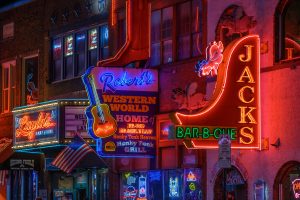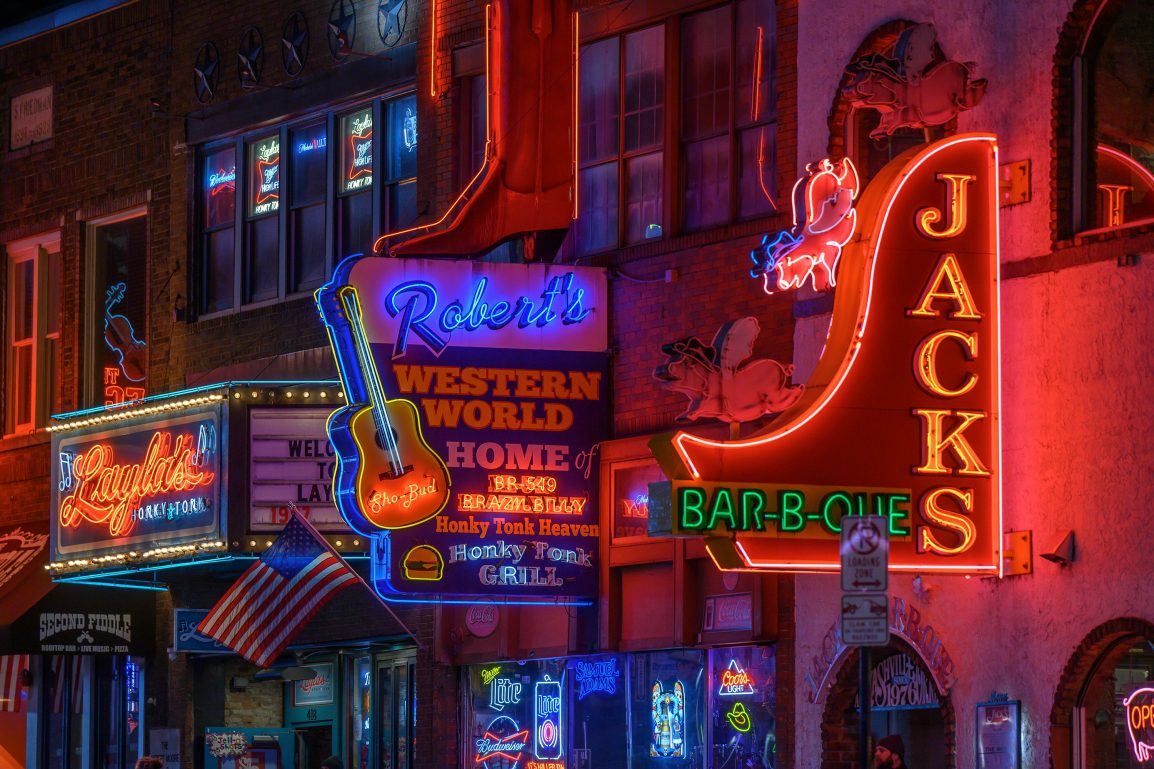
Image link: https://unsplash.com/photos/a-city-street-filled-with-lots-of-neon-signs-Ofnx8Ju7Lgc.
Nashville earns its name as the ‘Music City’ for a good reason. It isn’t just a city; it’s a living, breathing soundtrack to America’s musical soul. The city pulses with melodies from every corner. This vibrant Tennessee destination has shaped American music for generations.
From country anthems to gospel roots, the city’s landmarks tell stories that shaped genres. Whether you’re an R&B music fan or simply appreciate musical history, these four stops should top your Nashville itinerary. These icons offer unforgettable experiences that showcase Nashville’s rich musical heritage.
#1. Grand Ole Opry
No trip to Nashville is done without stepping into the Grand Ole Opry, the world’s most successful live radio program. It occupies a prominent place in country music. U.S. News & World Report ranks it as the best attraction to visit in Nashville.
The Opry has been a stage for countless legends for nearly a century. Many iconic careers in country music started right here. It continues to host both established stars and new, rising talents. Since 1925, icons like Dolly Parton and Keith Urban have graced its stage. You can also book the “Women of Country” tour to learn about the women who transformed country music.
But here’s a secret: the true magic happens behind the curtains. Book a backstage tour to walk through artists’ dressing rooms and peek at vintage costumes. You may even have the opportunity to explore Studio A, where the country music and humor show “Hee Haw” was filmed.
#2. Country Music Hall of Fame and Museum
Think of this museum as a time machine for music lovers. Its extensive collection takes you on a journey through the genre’s evolution. You can explore the history of country music from its early days to its modern forms.
According to the museum’s official website, it houses an unrivaled collection of more than 2 million artifacts. It has over 40,000 motion images on film, video, and digital forms, 500,000 photographs, and more than 300,000 audio tapes. Moreover, it houses about 800 historical audio clips, 2,500 clothing souvenirs and accessories, 600 musical tools, and 75,000 posters.
You’ll also find 5,000 linear feet of printed media and thousands of souvenirs showcasing the artistic heritage of country music. Every music lover will find something fascinating within its walls. Then, you have the “American Currents: State of the Music” exhibit. It’s a yearly snapshot of notable artist accomplishments, events, and perspectives in country music during the preceding year.
In August 2024, the museum added Marty Stuart’s collection of over 22,000 items to its archives. Stuart’s inventory is the finest personal collection of country music souvenirs in the world. It joins the world’s largest public inventory held by the museum. Some iconic pieces from Stuart’s collection include:
- Johnny Cash’s first black stage suit, c. 1955,
- Dolly Parton’s rhinestone-studded dress from the “The Porter Wagoner Show,” c. 1970,
- Luther Perkins’ guitar,
- Bob Dylan’s hat from his 1975 Rolling Thunder Revue concert tour.
The museum sits in a bustling downtown district full of restaurants and music venues. Many Nashville Airbnbs are located within easy walking distance, making it simple to explore multiple attractions without needing transportation. These rentals often offer more space and local character than standard hotels, with many featuring music-themed decor and full kitchens.
Music City Loft reveals that these properties can accommodate up to 10 people, making them ideal for large groups or families. Plus, staying in a neighborhood rental gives you a taste of authentic Nashville living that hotel districts simply can’t match. This central location allows you to immerse yourself in Nashville’s music scene beyond museum hours.
#3. Bluebird Café
For a more intimate musical experience, the Bluebird Café offers something truly special. This unassuming venue, opened in 1982, is located in a strip mall away from downtown. The site has become legendary for its songwriter nights and “in the round” performances. About 70,000 people visit this venue annually, making it among the top attractions in the city.
What makes the Bluebird unique is its focus on songwriters rather than performers. Here, you’ll learn about the stories behind famous songs from the artists who composed them. The venue’s small size, only 90 seats, creates an atmosphere unlike any other in Nashville. Only In Your State highlights the venue’s strict “shush policy” during performances.
This ensures artists receive complete respect and attention, allowing visitors to hear music in its purest form without typical concert distractions. Many successful music careers have launched from this humble stage. Garth Brooks was discovered here, and Taylor Swift caught her first big break during a Bluebird performance.
Grab dinner and listen closely. Many artists debut raw, unfiltered versions of songs later made famous by stars. Reservations run out quickly, so plan weeks ahead or arrive early for limited walk-in seats.
#4. National Museum of African American Music
The newest addition to Nashville’s musical landmarks, the National Museum of African American Music, provides essential context for understanding American music. This influential museum celebrates the often-overlooked contributions of Black musicians across all genres.
Through interactive exhibits, you can trace the evolution of African American music from its traditional roots through blues, jazz, R&B, and hip-hop. The National Association of Music Merchants notes that visitors can experience galleries like:
- Rivers of Rhythm Pathways
- Wade in the Water
- Crossroads
- A Love Supreme
- One Nation Under a Groove
- The Message
These galleries allow people to follow the evolution of African American music in an immersive, chronological journey. They help you understand how different musical genres influenced and shaped each other over time. The museum’s downtown location allows you to combine your visits to Nashville’s other musical attractions, creating a more complete picture of American musical heritage.
Additionally, FOX 17 reports that the museum will host its first traveling showcase in May 2025. The exhibit will tour over 20 states and highlight the Fisk Jubilee singers.
Commonly Asked Questions
Q1. What is the best time of year to visit Nashville for music events?
Spring and fall offer the most comfortable weather and the biggest music events in Nashville. CMA Fest in June brings the country’s greatest stars, while September’s Americana Music Festival showcases roots music. Winter visits mean fewer crowds and often better ticket availability for the Opry and Bluebird performances.
Q2. Are there other famous music venues besides these four in Nashville?
Don’t miss Ryman Auditorium, the “Mother Church of Country Music,” with its incredible acoustics and storied history. The Musicians Hall of Fame celebrates session players behind famous recordings. For vinyl lovers, Third Man Records (Jack White’s label) offers tours and exclusive Nashville pressings you can’t find elsewhere.
Q3. Can you visit the Grand Ole Opry without attending a show?
Yes! Daytime backstage tours run year-round. You can explore the dressing rooms, see the archived costumes, and learn about the Opry’s history. The adjacent Opry Plaza hosts free outdoor concerts seasonally. Nearby, Opry Mills Mall offers dining/shopping, which is ideal for non-show days.
Nashville’s musical landmarks offer more than entertainment; they provide insight into America’s cultural evolution. From the Opry’s grand tradition to the Bluebird Café’s songwriter-focused intimacy, these venues preserve musical history while nurturing its future. When arranging your itinerary, consider organizing your trip around special performances or exhibitions.
Weekday visits often mean smaller crowds and more personal experiences, especially at popular attractions like the Country Music Hall of Fame. So, plan your trip and delight yourself in the sounds and stories of Music City.

